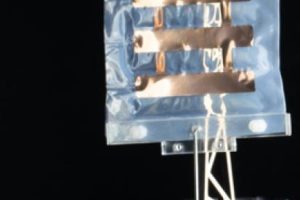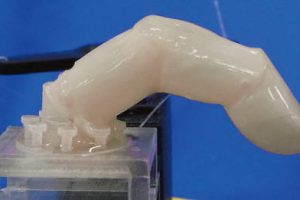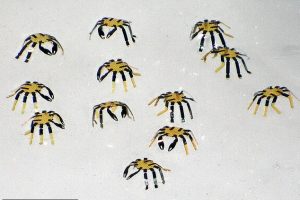Engineer Professor Francois Barthelat has been examining the mechanics that allow fins to be flexible and stiff at the same time, with muscles at the base imparting smooth ripples that exert considerable force on their environment.
“You get this dual capability where fins can morph, and yet they’re still quite stiff when they push water,” he said.
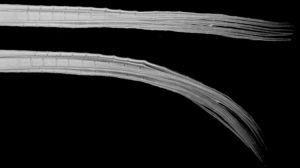 A fin ray, relaxed (top) and with differential force applied to its hemitrichs
A fin ray, relaxed (top) and with differential force applied to its hemitrichs
“If you look at a fin, you’ll see that it’s made of many stiff rays,” said Barthelat. “Each of those rays can be manipulated individually just like your fingers, but there are 20 or 30 of them in each fin.”
The rays are made from hard mineralised segmented strands called hemitrichs, joined edge to edge with much softer collagen, “making them the perfect balance between bouncy and stiff”, according to the university.
Pulling on one hemitrich and pushing on the next causes the ray to bend.
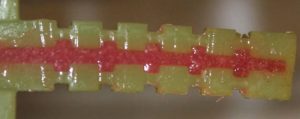 3d printed, this fin ray has the right mixture of sculptured stiff (yellow) and soft (pink) plastics
3d printed, this fin ray has the right mixture of sculptured stiff (yellow) and soft (pink) plastics
The team used computer simulations and 3d-printed structures to understand the biomechanics.
Real rays are segmented along their length, and it transpired that this is important as it periodically varies stiffness.
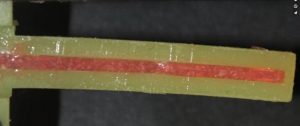
Modelled rays with constant stiffness along their length (right) proved too stiff to work effectively, while segmentation (above left) improved operation.
“Until recently, the function of those segments hadn’t been clear,” said Barthelat. “The segments, essentially, create these tiny hinges along the ray.”
“When you try to compress or pull on those bony layers, they have a very high stiffness,” he continued. “This is critical for the ray to resist and produce hydrodynamic forces that push on water. But if you try to bend individual bony layers, they’re very compliant, and that part is critical for the rays to deform easily from the base muscles.”
Where could this knowledge be used?
Flexible aircraft wings, for a start, said Barthelat. “Airplanes do this now, to some extent, when they drop their flaps, but that’s in a rigid way. A wing made out of morphing materials, in contrast, could change its shape more radically and in a continuous manner, much like a bird.”
The project has only scratched the surface, said Barthelat: “We like to pick up where the biologists and zoologists have left off, using our background in the mechanics of materials to further our understanding of the amazing properties of the natural world.”
The University of Colorado Boulder worked with the Catholic University of Louvain, the University of Sydney and MIT.
‘Segmentations in fins enable large morphing amplitudes combined with high flexural stiffness for fish-inspired robotic materials‘ describes the research in Science Robotics – payment required for the full paper.
 Electronics Weekly Electronics Design & Components Tech News
Electronics Weekly Electronics Design & Components Tech News

